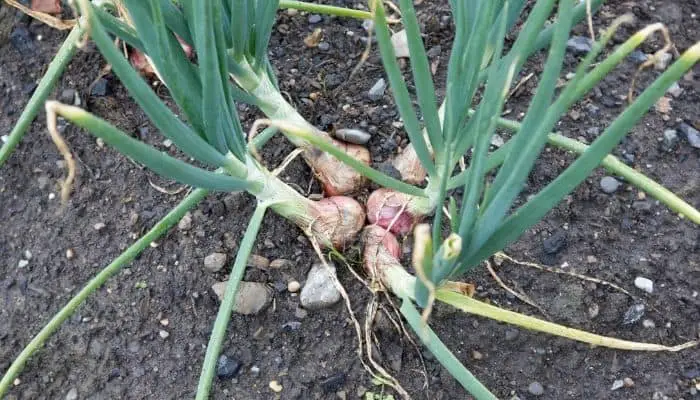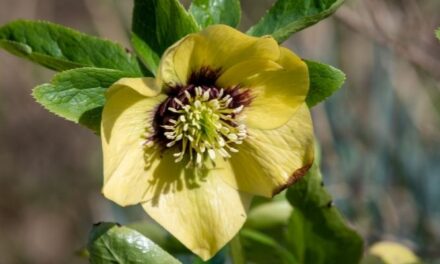The best vegetables to harvest are ones that are expensive to buy but super-easy to grow in your own backyard.
Shallots fall neatly into this criteria.
But growing large shallots from bulbs can be tricky and if you don’t get everything just right, you can easily end up with a harvest of tiny bulbs.
Table of Contents
Why Are My Shallots So Small?

Shallots can often grow small for a number of reasons including:
- They have been planted too close together and not given enough space to grow.
- The bulb was planted too deep in the soil.
- They have been planted in soil that is not rich enough.
- They have not been watered enough and allowed to dry out too much while growing.
- The shallot plant has been allowed to flower.
Sometimes, if you plant a large shallot bulb in the ground it can divide into a number of offsets and this can result in a harvest of smaller shallots.
Many growers find that planting smaller bulbs often results in a harvest of larger shallots.
Also Read: Is Growing Vegetables Near Trees a Good Idea?
3 Ways To Grow Shallots
There are several ways in which you can start growing shallots, they have a biennial vegetative cycle that offers several ways to start.
You can use seeds, offsets, or fully grown bulbs, even those purchased in a grocery store!
In this regard, they are very similar to both onions and garlic.
Growing From Seed
If the growing conditions are right, some of the shallot plants can flower and produce seeds.
These seeds can then be germinated and planted.
From seeds, you will produce plants with a single small bulb that needs to be transplanted in spring.
Depending on your area this can be done as early as mid-February and all the way to mid-March.
Growing From Offsets
Offsets or sets are in essence just underdeveloped bulbs.
You can buy sets at many stores that carry seeding material.
Sets are planted in mid-February till mid-March, depending on your area.
After 90 to 120 days they grow into fully ripe plants and their leaves start to brown.
This is a time when you can harvest them.
Growing From Bulbs
If you plant fully grown bulbs, such as ones you can buy at grocery stores, in the autumn, during the winter it will divide into 3 to 20 offsets.
If you leave them in the ground they will not grow very large because they are all crowded and fighting for nutrients.
Instead, you should separate them from each other and replant them in the spring same as you would do with store-bought sets.
The Best Growing Conditions For Large Shallots?
Soil
Shallots prefer well-drained soil with relatively stable moisture content.
And if you want to increase the chances of producing a yield of large bulbs, the soil needs to be rich in nutrients while remaining light so that small shallot sets can transform into big bulbs.
Planting
They need to be planted in rows, 6 to 7 inches apart, with rows being separate 12 inches between them.
This way they will have enough space for growth.
While planting, you should leave tips of the offsets poking above the ground level.
If any of your plants start developing flowers, you should cut them off so energy can be directed into growing the bulbs.
Seeds require large amounts of nutrients, and plants that are allowed to continue flowering will always produce small bulbs.
Watering
Only water your shallots during dry spells of weather.
Just like other onions, they experience a growth spurt when there is too much water in the ground, which leads to the bursting of the outer protective shell of the bulb and eventual rotting.
Periods of low moisture will prematurely end the vegetation period and produce small bulbs.
Enrich And Fertilize The Soil
The soil rich with compost should be further enriched with well-rotten manure, and shallot prefers a well-lit position for proper growth.
Shallots require plenty of nitrogen if you want them to grow big.
Supplement plants with the feeding of nitrogen-based fertilizer about 21 days after planting and continue to fertilize about once a month thereafter.
Use an ammonium sulfate fertilizer if your soil is alkaline and an ammonium nitrate fertilizer if your soil is acidic.
This helps to modify the pH levels of your soil to best suit the growth of shallots.
Stop fertilizing roughly one month before harvest.
How Big Should Shallots Be Grown?
Shallots vary greatly in size, the overall height of the plants can be between one and two feet.
When it comes to the size of bulbs, if they are under ⅜ of an inch in diameter they are considered to be small.
Between ⅜ and ¾ inches in diameter, they are considered average or medium, while over ¾ inches in diameter are big ones.
When Should I Harvest My Shallots?
Just like garlic and onions, shallots will show you when they are ready to be lifted.
If you have planted them in spring, between 90 and 120 days later their leaves will start to wilt.
Once the leaves are fully browned, they can be harvested.
The easiest way to harvest them is by using a spading fork to loosen the dirt around them.
At this point, you can consume them, but if you are planning on storing them there is another step.
They should be stored on wire racks or trays in a shady but well ventilated and dry place for three weeks.
After this, you can cut or pull off dried leaves and store them in a dry place at a temperature of around 50 degrees F.
Final Thoughts
Shallots are really easy to grow but whether or not you’ll have a harvest of nice big bulbs will depend on a few things.
By following along with the tips in this guide, I’m sure you’ll have better luck growing larger shallots.




